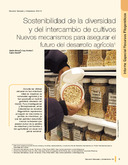Mostrar el registro sencillo del ítem
Sostenibilidad de la diversidad y del intercambio de cultivos Nuevos mecanismos para asegurar el futuro del desarrollo agrícola1
| dc.contributor.author | Frison, Emile | |
| dc.contributor.author | Fowler, Cary | |
| dc.contributor.author | Snook, Laura | |
| dc.date.accessioned | 2019-08-30T15:14:46Z | |
| dc.date.available | 2019-08-30T15:14:46Z | |
| dc.date.issued | 2008-04 | |
| dc.identifier.issn | ISSN: 1659-1216 | ISSN |
| dc.identifier.uri | https://repositorio.catie.ac.cr/handle/11554/9168 | |
| dc.description | Ilustrado, 11 páginas, 32 referencias. | |
| dc.description.abstract | La diversidad de especies cultivadas para la agricultura y la alimentación es uno de los recursos principales para aumentar la producción de alimentos. En combinación con el uso de mayores cantidades de agua, pesticidas y fertilizantes, el desarrollo de nuevas variedades a partir de las ya existentes impulsó la “Revolución Verde” que incrementó sustancialmente los rendimientos en décadas pasadas. Sin embargo, los productores de tierras marginales con serias dificultades para incrementar el uso de insumos adicionales, todavía requieren de soluciones para reducir la vulnerabilidad de sus cultivos ante sequías, inundaciones, plagas y enfermedades, y para aumentar su producción. Sus necesidades podrían satisfacerse si recurriéramos de nuevo a la diversidad de cultivos para tratar de encontrar diferentes combinaciones de rasgos deseables. Desafortunadamente, la recolección e intercambio de recursos genéticos para la agricultura y la alimentación ha sido restringida, en años recientes, por barreras derivadas del ejercicio de derechos soberanos sobre plantas que antes se consideraban herencia de la humanidad. El Tratado Internacional sobre los Recursos Fitogenéticos para la Alimentación y la Agricultura (el Tratado) entró en vigencia en el 2004, para salvaguardar el acceso a dichos recursos. Al mismo tiempo, se creó el Fondo Mundial para la Diversidad de Cultivos, para apoyar la conservación y la disponibilidad de la diversidad agrícola en bancos genéticos alrededor del mundo. En América Latina hay seis redes que trabajan con recursos fitogenéticos para tratar de asegurar la disponibilidad y uso futuros de tales recursos. El objetivo de esos esfuerzos es alcanzar el objetivo de Desarrollo del Mileno relacionado con la erradicación del hambre y la pobreza mediante la intensificación de la agricultura diversificada. | |
| dc.description.abstract | The diversity within crop species (PGRFA) is a principal resource for increasing food production. In combination with increased inputs of water, pesticides and fertilizers, the breeding of new varieties from existing ones fuelled the “Green Revolution”, which led to huge increases in yields in past decades. However, farmers on marginal lands, for whom the addition of inputs is not feasible, still need solutions to reduce the vulnerability of their crops to drought, flooding, pests and diseases, and increase their production. Their needs can be met by tapping again into the diversity of crops, seeking a different mix of traits. Unfortunately, collection and exchange of PGRFA has been hampered in recent years by barriers resulting from the overlaying of sovereign rights over plants that had previously been considered the heritage of humankind. The International Treaty on Plant Genetic Resources for Food and Agriculture (ITPGRFA) came into force in 2004 to safeguard access to those resources. At the same time, The Global Crop Diversity Trust was established to sup port the long-term conservation and availability of crop diversity in genebanks around the world. Six plant genetic resources networks in Latin America are working together to develop ways of ensuring the future availability and use of PGRFA, in order to address, through diversity-based agricultural intensification, the Millennium Development goal of eradicating hunger and poverty. | |
| dc.format.mimetype | ||
| dc.language.iso | es | es_ES |
| dc.publisher | CATIE, Turrialba (Costa Rica) | es_ES |
| dc.publisher | CATIE, Turrialba (Costa Rica) | |
| dc.relation.ispartof | Recursos Naturales y Ambiente Número 53 (Abril 2008), páginas 9-19 | |
| dc.rights | info:eu-repo/semantics/openAccess | es_ES |
| dc.rights | info:eu-repo/semantics/openAccess | |
| dc.rights.uri | https://creativecommons.org/licenses/by-nc-nd/4.0/ | |
| dc.subject | RECURSOS GENETICOS | |
| dc.subject | RECURSOS GENETICOS VEGETALES | |
| dc.subject | CONSERVACION DE LOS RECURSOS | |
| dc.subject | BANCO DE GENES | |
| dc.subject | REDES DE INVESTIGACION | |
| dc.subject | SEGURIDAD ALIMENTARIA | |
| dc.subject | ACUERDOS INTERNACIONALES | |
| dc.title | Sostenibilidad de la diversidad y del intercambio de cultivos Nuevos mecanismos para asegurar el futuro del desarrollo agrícola1 | es_ES |
| dc.title.alternative | Sustaining plant diversity and exchange: New mechanisms to ensure the future of agricultural development. | |
| dc.type | Artículo | es_ES |
| dc.journal.issueNumber | 53 | |
| dc.journal.pages | 9-19 |



